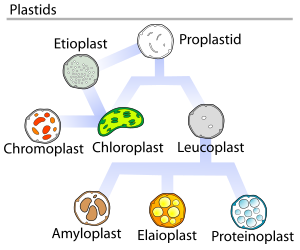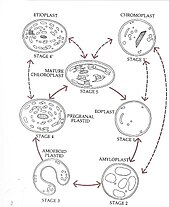Plastid
| Plastid | |
|---|---|

| |
| Plant cells with visible chloroplasts
| |
| Scientific classification | |
| Domain: | Bacteria |
| Phylum: | Cyanobacteria |
| Clade: | Plastid |
A plastid (from
Examples of plastids include chloroplasts (used for photosynthesis); chromoplasts (used for synthesis and storage of pigments); leucoplasts (non-pigmented plastids some of which can differentiate); and apicoplasts (non-photosynthetic plastids of apicomplexa derived from secondary endosymbiosis).
A permanent primary endosymbiosis event occurred about 1.5 billion years ago in the
In land plants


Chloroplasts, proplastids, and differentiation
In
Other plastids can synthesize
All plastids are derived from proplastids, which are present in the
Plant proplastids (undifferentiated plastids) may differentiate into several forms, depending upon which function they perform in the cell, (see top graphic). They may develop into any of the following variants:[10]
- Chloroplasts: typically green plastids that perform photosynthesis.
- Etioplasts: precursors of chloroplasts.
- Chromoplasts: coloured plastids that synthesize and store pigments.
- Gerontoplasts: plastids that control the dismantling of the photosynthetic apparatus during plant senescence.
- Leucoplasts: colourless plastids that synthesize monoterpenes.
Leucoplasts differentiate into even more specialized plastids, such as:
- the aleuroplasts;
- Amyloplasts: storing starch and detecting gravity—for maintaining geotropism.
- Elaioplasts: storing fats.
- Proteinoplasts: storing and modifying protein.
- or polyphenols.
Depending on their morphology and target function, plastids have the ability to differentiate or redifferentiate between these and other forms.
Plastomes and Chloroplast DNA/ RNA; plastid DNA and plastid nucleoids
Each plastid creates multiple copies of its own unique genome, or
A plastome typically contains a
Many plastids, particularly those responsible for photosynthesis, possess numerous internal membrane layers. Plastid DNA exists as protein-DNA complexes associated as localized regions within the plastid's inner envelope
Where the proplastid (undifferentiated plastid) contains a single nucleoid region located near the centre of the proplastid, the developing (or differentiating) plastid has many nucleoids localized at the periphery of the plastid and bound to the inner envelope membrane. During the development/ differentiation of proplastids to chloroplasts—and when plastids are differentiating from one type to another—nucleoids change in morphology, size, and location within the organelle. The remodelling of plastid nucleoids is believed to occur by modifications to the abundance of and the composition of nucleoid proteins.
In normal plant cells long thin protuberances called stromules sometimes form—extending from the plastid body into the cell cytosol while interconnecting several plastids. Proteins and smaller molecules can move around and through the stromules. Comparatively, in the laboratory, most cultured cells—which are large compared to normal plant cells—produce very long and abundant stromules that extend to the cell periphery.
In 2014, evidence was found of the possible loss of plastid genome in Rafflesia lagascae, a non-photosynthetic parasitic flowering plant, and in Polytomella, a genus of non-photosynthetic green algae. Extensive searches for plastid genes in both taxons yielded no results, but concluding that their plastomes are entirely missing is still disputed.[13] Some scientists argue that plastid genome loss is unlikely since even these non-photosynthetic plastids contain genes necessary to complete various biosynthetic pathways including heme biosynthesis.[13][14]
Even with any loss of plastid genome in Rafflesiaceae, the plastids still occur there as "shells" without DNA content,[15] which is reminiscent of hydrogenosomes in various organisms.
In algae and protists
Plastid types in algae and protists include:
- Chloroplasts: found in green algae (plants) and other organisms that derived their genomes from green algae.
- Muroplasts: also known as cyanoplasts or cyanelles, the plastids of glaucophyte algae are similar to plant chloroplasts, excepting they have a peptidoglycan cell wall that is similar to that of bacteria.
- Rhodoplasts: the red plastids found in red algae, which allows them to photosynthesize down to marine depths of 268 m.[10] The chloroplasts of plants differ from rhodoplasts in their ability to synthesize starch, which is stored in the form of granules within the plastids. In red algae, floridean starch is synthesized and stored outside the plastids in the cytosol.[16]
- Secondary and tertiary plastids: from endosymbiosis of green algae and red algae.
- Leucoplast: in algae, the term is used for all unpigmented plastids. Their function differs from the leucoplasts of plants.
- Apicoplast: the non-photosynthetic plastids of Apicomplexa derived from secondary endosymbiosis.
The plastid of photosynthetic Paulinella species is often referred to as the 'cyanelle' or chromatophore, and is used in photosynthesis.[17][18] It had a much more recent endosymbiotic event, in the range of 140–90 million years ago, which is the only other known primary endosymbiosis event of cyanobacteria.[19][20]
Etioplasts, amyloplasts and chromoplasts are plant-specific and do not occur in algae.[citation needed] Plastids in algae and hornworts may also differ from plant plastids in that they contain pyrenoids.
Inheritance
In reproducing, most plants inherit their plastids from only one parent. In general,
In normal intraspecific crossings—resulting in normal hybrids of one species—the inheriting of plastid DNA appears to be strictly uniparental; i.e., from the female. In interspecific hybridisations, however, the inheriting is apparently more erratic. Although plastids are inherited mainly from the female in interspecific hybridisations, there are many reports of hybrids of flowering plants producing plastids from the male. Approximately 20% of angiosperms, including alfalfa (Medicago sativa), normally show biparental inheriting of plastids.[21]
DNA damage and repair
The plastid DNA of maize seedlings is subjected to increasing damage as the seedlings develop.[22] The DNA damage is due to oxidative environments created by photo-oxidative reactions and photosynthetic/ respiratory electron transfer. Some DNA molecules are repaired but DNA with unrepaired damage is apparently degraded to non-functional fragments.
Origin
Plastids are thought to be descended from
The plastid of photosynthetic Paulinella species is often referred to as the 'cyanelle' or chromatophore, and had a much more recent endosymbiotic event about 90–140 million years ago; it is the only known primary endosymbiosis event of cyanobacteria outside of the Archaeplastida.[17][18] The plastid belongs to the "PS-clade" (of the cyanobacteria genera Prochlorococcus and Synechococcus), which is a different sister clade to the plastids belonging to the Archaeplastida.[4][5]
In contrast to primary plastids derived from primary endosymbiosis of a prokaryoctyic cyanobacteria, complex plastids originated by secondary
Some
Plastid development cycle

In 1977 J.M Whatley proposed a plastid development cycle which said that plastid development is not always unidirectional but is instead a complicated cyclic process. Proplastids are the precursor of the more differentiated forms of plastids, as shown in the diagram to the right.[28]
See also
- Mitochondrion – Organelle in eukaryotic cells responsible for respiration
- Cytoskeleton – Network of filamentous proteins that forms the internal framework of cells
- Photosymbiosis – A type of symbiotic relationship where one organism is capable of photosynthesis
Notes
- ^ Sometimes Ernst Haeckel is credited to coin the term plastid, but his "plastid" includes nucleated cells and anucleated "cytodes"[7] and thus totally different concept from the plastid in modern literature.
References
- ISBN 978-1-4020-4060-3.
- PMID 31354692.
- PMID 28893840.
- ^ PMID 17550603.
- ^ PMID 25222494.
- ^ Schimper, A.F.W. (1882) "Ueber die Gestalten der Stärkebildner und Farbkörper" Botanisches Centralblatt 12(5): 175–178.
- ^ Haeckel, E. (1866) "Morphologische Individuen erster Ordnung: Plastiden oder Plasmastücke" in his Generelle Morphologie der Organismen Bd. 1, pp. 269-289
- ^ Picozoans Are Algae After All: Study | The Scientist Magazine®
- ^ Kolattukudy, P.E. (1996) "Biosynthetic pathways of cutin and waxes, and their sensitivity to environmental stresses", pp. 83–108 in: Plant Cuticles. G. Kerstiens (ed.), BIOS Scientific publishers Ltd., Oxford
- ^ ISBN 978-1-4020-4060-3.
- PMID 21424877.
- ISBN 9780128134573.
- ^ a b "Plants Without Plastid Genomes". The Scientist. Retrieved 2015-09-26.
- PMID 16406301.
- ^ "DNA of Giant 'Corpse Flower' Parasite Surprises Biologists". April 2021.
- PMID 11429143.
- ^ PMID 30796245.
- ^ PMID 32289879.
- PMID 28808007.
- Wikidata Q36374426.
- S2CID 5108244.
- PMID 25261192.
- PMID 26579143.
- PMID 28407383.
- PMID 25222494.
- PMID 15005799.
- ^ Chan CX, Bhattachary D (2010). "The Origin of Plastids". Nature Education. 3 (9): 84.
- JSTOR 2431207.
Further reading
- Hanson MR, Köhler RH. "A Novel View of Chloroplast Structure". Plant Physiology Online. Archived from the original on 2005-06-14.
- Wycliffe P, Sitbon F, Wernersson J, Ezcurra I, Ellerström M, Rask L (October 2005). "Continuous expression in tobacco leaves of a Brassica napus PEND homologue blocks differentiation of plastids and development of palisade cells". The Plant Journal. 44 (1): 1–15. PMID 16167891.
- Birky CW (2001). "The inheritance of genes in mitochondria and chloroplasts: laws, mechanisms, and models" (PDF). Annual Review of Genetics. 35: 125–48. PMID 11700280. Archived from the original(PDF) on 2010-06-22. Retrieved 2009-03-01.
- Chan CX, Bhattacharya D (2010). "The origins of plastids". Nature Education. 3 (9): 84.
- Bhattacharya D, ed. (1997). Origins of Algae and their Plastids. New York: Springer-Verlag/Wein. ISBN 978-3-211-83036-9.
- Gould SB, Waller RF, McFadden GI (2008). "Plastid evolution". Annual Review of Plant Biology. 59: 491–517. S2CID 30458113.
- Keeling PJ (March 2010). "The endosymbiotic origin, diversification and fate of plastids". Philosophical Transactions of the Royal Society of London. Series B, Biological Sciences. 365 (1541): 729–48. PMID 20124341.
External links
- Transplastomic plants for biocontainment (biological confinement of transgenes) — Co-extra research project on coexistence and traceability of GM and non-GM supply chains
- Tree of Life Eukaryotes
